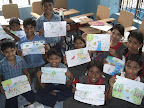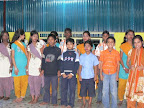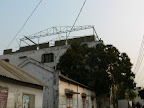OFFICE:
Data: 1 project director; 1 project director assistant; 1 education director; 1 volunteer director; 1 accountant manager; 1 project activities manager; 4 staff members not defined; other (cleaning/door guard staff).
Firstly, the power cuts and the internet breakdowns were, many times, an excuse to do nothing and there have even been cases of people sleeping (there is even a bed in the place).
The number of people in the office seems to be more than the enough, once it is not clearly known what is the duty of each one, and more important yet, what they are responsible for. Much of their time is spent using informatics tools “Facebook”, or on the other side, they didn't even turn up in the office, showing illness as an excuse, “Sick”.
Second, it wasn't possible to foresee the results obtained with the basic needs shop, the clothes shop or the sewing shop once, as we have been informed, these three activities had had their start on 1st July, 2008. Later we came to know that the person in charge – BABU – had assumed his post in the same day and didn't know about nothing ocurred before.
A money sponsorship given to provide food to The Dhaka Project students is being used in the basic needs shop, to implement the “Food For Thought” programme that consists, basically, in the distribution of 20% discount cards in rice, dahl and oil only for the students present in the schools for 5 consecutive days.
It happens that, from the target public (the students and their families), only 50% have joined in the first week, percentage that has decreased along the following weeks. From which we can conclude that the programme hadn's had the desired effect.
(There are 2-day gaps without food).
On the other hand, the people in charge were yielding a discount on the selling price of the products and not on the cost price. This take us to the conclusion that part of the money from the sponsorship would remain in the shop profit so not going to who it should go, i.e., to the students in the form of food.
NURSERY:
Data: 41 kids; 3 educators; 3 cleaning staff
The children were dressed with dirty clothes many times and sometimes had some bad smell.
Washing powder and more missing items filled a long list such as cleaning products, nappies, and the lack of milk powder and baby food to the children.
Nayan, who was responsible for the shopping, when we showed him the list of missing items, said that he had only been in that duty for 11 days and didn't know what had happened before. But when we showed him the items missing he let out saying that the shopping depended on the money received from the office.Also in this case we didn't realise who were truly responsible but there is no doubt that the kids are who suffer, not having the deserved conditions, the conditions kept in mind by the project and announced to sponsors/donators.
Even after Maria had contracted a nutritionist to build a menu for the children, the lunch was always rice and vegetables.
There are children in the nursery, who are old enough to be in the preschool but this is not cared by who should manage this the project.
PRESCHOOL:
Data: 28 students; 2 educators; 2 auxiliary staff
Generally, there was a permanent concern in keeping the children clean and dressed with their uniforms in this school.
However, when we counted the students to take pictures the people in charge seemed nervous when reporting 26 existing students and they assumed that there were only 23 effective students.
There are children here, who are old enough to be in primary school but it isn't cared by who should manage this project.
THE SCHOOL IN THE HEADQUATERS BUILDING OF THE DHAKA PROJECT:
Data: 136 students; 6 teachers; one principal;
Concerning to the staff we couldn't find out, once we were in the main building.
In this school, the classes took place in rooms where the desks and chairs were very close, preventing the kids to walk easily between them. One of these rooms didn't have a window, but there were empty rooms with windows in the building.
Here, the kids were guaranteed to have their lunch in an improvised canteen having a scanty room to have their meal. The menu was always rice and vegetables. However, classes rarely took place in the afternoon period.
THE NEW SCHOOL:
Data: Students: about 374; Teachers 22 + 4 students teachers; cleaning staff: 6 + 3 street sweepers; doormen: 3; at least one director, one principal, one principal assistant...; 16 classrooms; one computer lab; one teachers room; one director room.
The school opens at 8 AM and closes at 15:30 PM, having a lunch break from 13:30 to 14:30 PM.
This school provides the students with two meals, during two moments, one in the morning and other in the afternoon, and these meals consist in the delivery of bread and banana to each one of the students. During lunch break, the students who leave closer go eat at home, the others stay by the school even without food.
Following an exhaustive identification work with this school's students we concluded that from the 427 students claimed by its director no more than 360 were present, that the teachers don't know the names of the students and, maybe due to that, they've never been able to tell us where to find he missing students.
We found strange situations, for example, while we were taking photos in a certain classroom we found out that one of the students had conjunctivitis, so we thought, but in such a condition that he couldn't open his eyes and he could do nothing but crying. We had to make this student go to the medical centre immediately though the teachers would only allow him to go during next break.
According to books we looked in the number of students enrolled in a class should be 44 but the classroom where they should be, has chairs for only 32, we found small classrooms with many students and large classrooms with few students.
If we take in account that the available classrooms are only 16 we can take the conclusion that there are 8 teachers with no students in a daily basis. This, not considering the presence of the volunteer teachers present daily in the school, at the time there were 3.
CONCLUSIONS:
The human structure of the project direction not only has a great number of unnecessary staff but also works without a sense of responsibility, where the status of the job is considered as the most important achievement. So, there is neither effective connection between the human structure nor efficient control on each one's responsibility.
The vision of the project, providing food and then providing education, appears distorted from the real situation once not all the students are provided with food and the standards previously defined aren't being followed.
FINALLY, THE NUMBERS CLAIMED, SOMETIMES 650, OTHER TIMES 750 STUDENTS, ARE REALLY NOT MORE THAN 579.
(Observed from 21st July to 4th August, 2008).






1 comment:
Have been following this blog since I took interest in the project a few months ago. Was moved by the voluntarism and spirit of sacrifice of the promoters and made a small donation. Probably will donate more in the future.
It is important that donors (even small donors like me) feel their money is being well used, so it seems at first sight that such negative reports are very damaging to the project. (There was another such report a couple of months ago.)
On the other hand, it is reassuring to see that the project management is open enough to allow such negative opinions to be expressed on their own blog. How many western organizations would allow it? This is a healthy sign.
Indeed, all organizations - made from real people - have their shortcomings. Don't know a single one that may be considered perfect. Success lies in the permanent struggle that a competent management should wage against the inefficient tendencies that unavoidably will erupt (laziness, carelessness, cheating, stealing, nepotism, etc). Failure to do so will bring down the organization by internal bleeding of its resources. (Know many notorious examples in my own country – not particularly shiny in this aspect…)
Hope that the project top management will find the energy and the sensitivity to look into these apparent problems. A little feedback on the blog would be nice…
Paulo Fonte
Coimbra
Portugal
Post a Comment